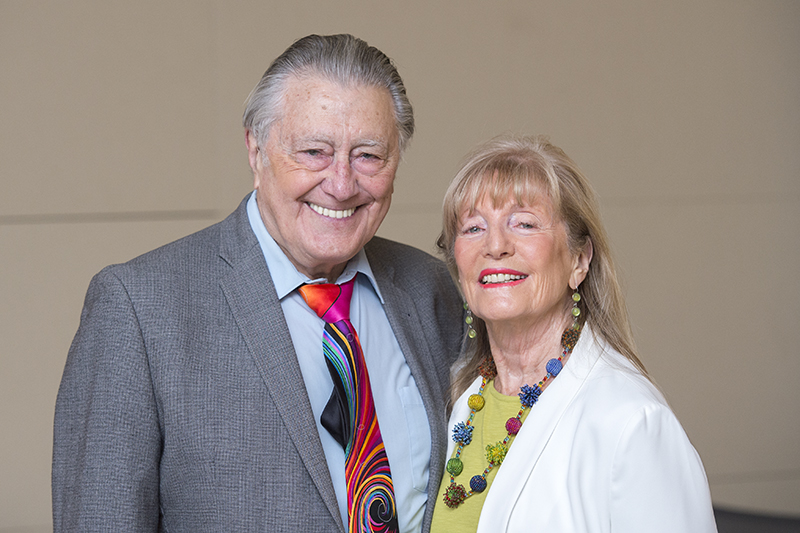Research world turns to EVMS for study of peripheral nerve damage

In a recent issue of the prestigious New England Journal of Medicine, two seemingly distinct articles about nerve damage written by teams from France and Portugal shared one common connection — a research center in Norfolk, Va.
Both studies used a questionnaire called the Norfolk QOL-DN (Quality of Life-Diabetic Neuropathy) tool to help analyze their research results. The questionnaire was developed by the EVMS husband-and-wife team of Aaron “Arthur” Vinik, MD, PhD, and Etta Vinik, MEd, to help identify peripheral nerve damage (also known as neuropathy) and determine its severity.
Once ridiculed for their unconventional approach to measuring quality of life, the Viniks today have an international audience of physicians-scientists lining up to use their questionnaire.
The U.S. Food and Drug Administration now requires that all clinical trials on new therapies for neuropathy use the Norfolk QOL, and the questionnaire has become the international standard for research involving various types of neuropathy. It has been translated into 56 languages — so far.
The seemingly simple, three-page questionnaire is actually the result of 20-plus years of testing and refinement, according to Dr. Vinik, the Murray Waitzer Endowed Chair for Diabetes Research, Professor of Internal Medicine and Director of Research and the Neuroendocrine Unit at the EVMS Strelitz Diabetes Center; and Etta Vinik, who recently retired from her roles as Associate Director of Education at the Strelitz Diabetes Center and Education Director of the EVMS Sleep Medicine Fellowship program.
“Arthur got the concept to develop a questionnaire to use in the clinic,” Etta Vinik recalls. “It was derived from information described by patients with diabetic neuropathy. They would say, ‘Oh, my feet are burning. It feels as though I’m walking on hot coals.’ Another person would say, ‘It feels as though I’ve got electric shocks.’ Others would say, ‘I can’t feel hot or cold,’ or ‘I put my hand on the stove and burned it. I didn’t realize it was hot.’ We used those exact descriptors to develop the questionnaire.”
Etta Vinik took on the task of crafting the questionnaire. Initially, it was designed to help clinicians care for their patients, but the Viniks soon came to see it as a much more powerful tool.
A few years later at a national conference, her poster presentation attracted the attention of the pharmacology giant Eli Lilly, which subsequently used a German-translated version of the Norfolk questionnaire as part of a multinational study that included Germany. The questionnaire worked well, even though the German population typically had much more severe nerve damage than in the U.S.
“We were able to see that it worked in different degrees of neuropathy severities, and in different languages and cultures,” she explains.
In another example of globalization, EVMS licensed the questionnaire for use in a multi-center study of neuropathy in Romania, working with more than 200 physicians. The results were dramatic.
“Of the 25,000 people in the study, 6,600 were found to have neuropathy just based on the questionnaire,” Dr. Vinik says. “This was the first time the tool was shown to have the ability to discover neuropathy just by asking questions.”
But beyond the excitement that it worked as promised, the questionnaire proved even more valuable. The Romanian researchers used the questionnaire not only to detect neuropathy, but to see how neuropathy progresses and to test the effectiveness of new experimental treatments.
“We can do all of that with just a questionnaire,” Dr. Vinik says.
Neuropathy commonly is associated with diabetes. But the studies published in the New England Journal of Medicine earlier this year were testing for a different kind of neuropathy associated with transthyretin amyloidosis, a genetic disorder. Again, the questionnaire proved accurate.
The success of the questionnaire for a range of neuropathies has propelled the Viniks to create similar questionnaires for two other conditions: fatigue, which is very common in people with diabetes, and neuroendocrine tumors.
Beyond the distinction for creating the questionnaire, Dr. Vinik continues to work with colleagues worldwide to find an effective treatment for diabetic neuropathy. He’s excited about two experimental drugs he’s worked with and had a hand in developing.
Those research studies are independent, but they will share at least one trait: the use of the Norfolk QOL questionnaire to help determine if the drugs work.